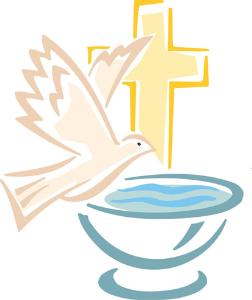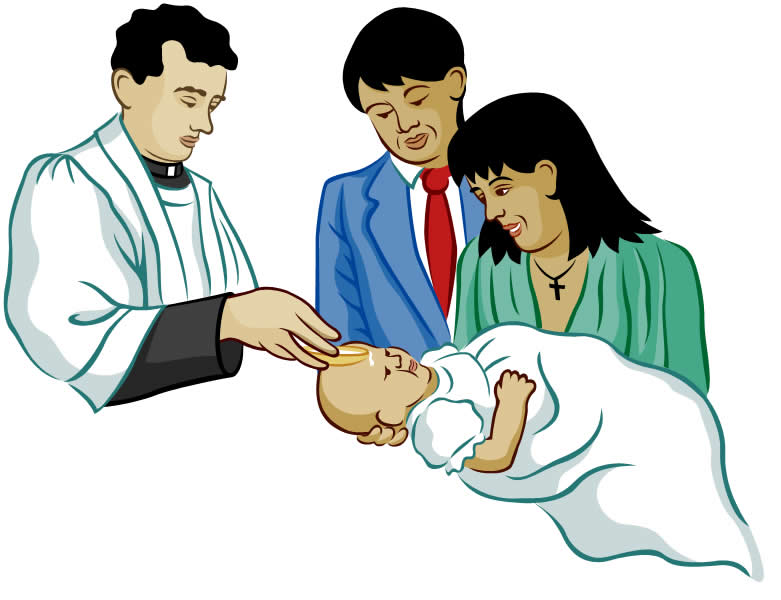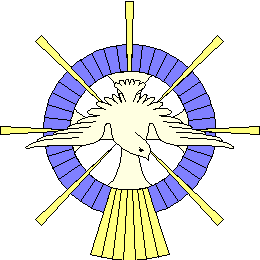The Sacrament Of Baptism – The Door Of The Church


The Sacrament of Baptism is often called “The door of the Church,” because it is the first of the seven sacraments not only in time (since most Catholics receive it as infants) but in priority, since the reception of the other sacraments depends on it. You cannot validly receive any other sacrament, if you are not baptized. It is the first of the three Sacraments of Initiation, the other two being the Sacrament of Confirmation and the Sacrament of Holy Communion. Once baptized, a person becomes a member of the Church. Traditionally, the rite (or ceremony) of baptism was held outside the doors of the main part of the church, to signify this fact.
The Sacrament of Baptism is the most beautiful thing that happens in someone’s life. Did you know that when someone is baptized, it means that God the Father, the Son, Jesus Christ and the Holy Spirit, give the Christian many very special gifts? To be baptized in the Catholic Church means more then being sprinkled with water on one’s head and receiving a Christian name.
The word ‘Baptism‘ comes from a Greek word that means to ‘plunge‘ or ‘immerse‘. To ‘plunge‘ someone in water represents the person dying, being buried and resurrecting with Christ as a ‘new creature.’ (C.C.C. # 1214) Some call this Sacrament ‘the washing of regeneration and renewal by the Holy Spirit‘ because Baptism results in a new birth of water and the Spirit. Without it, no one can enter the Kingdom of God. [Jn. 3:5] (C.C.C. # 1215)
This ‘bath‘ is called ‘enlightenment‘. That is because those who are preparing to receive this Church Sacrament will receive spiritual teachings from the Holy Bible and the Catechism of the Catholic Church. Enlightened by Jesus who is the Light of the world [Jn. 1:9], the new Christians now have the potential of becoming ‘children of light‘. [1 Thess. 5:5; Heb. 10:32; Eph. 5:8] (C.C.C. # 1216, 122).
Baptism is a ceremony in which the baptized person is immersed in water. Christians remember how Christ ‘drowned’ in suffering and death and rose again to new life. In the ceremony Christians believe that their past sins are washed away and they are now pure in Gods eyes as Christ was raised from the dead.
In the Roman Catholic Church people are usually baptized when they are infants – this is called infant baptism. When an infant is baptized they are welcomed in to the community of the church. Parents and the godparents make the promises of baptism on behalf of the child until they are old enough to profess their own belief.
Although they have not committed any actual sins, Catholics believe that baptism washes away original sin, the sin which everyone is born into.
The Rite Of Baptism
Through the Sacrament of Baptism, the believer is born as a Christian, as another “Christ.” Through this privilege, he enters a new and Divine life – sharing in the life of God. Becoming a member of the spiritual Body of Christ, he now has the mind of Christ in his thoughts, words and actions.
The Reception Of The Child
Because of the importance of the Sacrament of Baptism, whenever possible, this event takes place on a Sunday in the presence of the faithful. This Sacrament involves the relatives, friends and neighbours.
The Symbol Of Water
Water is used during the Sacrament of Baptism because it is a symbol of the Holy Spirit. It shows the actions of the Holy Spirit during the rebirth of Baptism in God. (C.C.C. # 1213) From the believer’s heart will flow rivers of living water. [Jn. 4:10; 7:38-9]
From the Holy Spirit flow all the blessings [Rev. 21:6] of Jesus who was crucified. The Sacrament of Baptism allows the new Christian to drink of the Holy Spirit, (C.C.C. # 694) to be sanctified so he may inherit the Kingdom of God.
During the ceremony of Baptism, the priest says a prayer of blessing, asking that the water within the baptismal basin be filled with the power of the Holy Spirit. Touching the water with his right hand, he asks the Heavenly Father to send the Holy Spirit upon the water that will be used for the baptism of the child (or adult).
The Prayers Of Exorcism
During the Sacrament of Baptism, the Priest says two prayers of Exorcism. The first one is said after the reading of the Gospel. During that prayer, the Priest commands any impure spirits who might be present to depart from the person to be baptized. This process is to purify the physical body of the believer. The spiritual body does not need purification because a new creation will be born when the sinful one dies.
The second prayer of Exorcism is called “Ephpheta.” (Ephpheta means ‘Be opened’) After the prayer, the Priest touches the ears and mouth of the child with his thumb. He then says, “The Lord Jesus made the deaf hear and the dumb speak. May He soon touch your ears to receive His Word, and your mouth to proclaim His faith, to the praise and glory of God the Father.”
The Oil Of Catechumens
This is one of the three holy oils that is used to administer the sacraments. It is mostly used in the sacrament of baptism, which is where it got its name from – the person who is about to receive a sacrament is called a catechumen. Apart from baptism, it is also used on other occasions such as the ordination of priests and church consecration.
Now before anointing the child with the oil of catechumens, the priest proceeds to invoke God to set the child free of original sin, to become a Temple of His glory in which will dwell the Holy Spirit.
The Oil Of Chrism
The Sacred Chrism is perfumed oil that has been consecrated by the Bishop. (C.C.C. # 1241) When the Priest anoints the one to be baptized, he asks God to bless the believer with all the necessary graces to achieve a Christian life. The Word ‘Christian’ comes from the name of ‘Christ’ which means ‘Anointed One’. The baptized person is admitted into the common priesthood of which Jesus is the High Priest.
The White Garment
The white garment represents putting on Christ. Announcing that the believer has become a new creature, having been clothed with Christ, the Priest places the white garment on the new Christian. He then proclaims that this garment is the outward sign of the believer’s Christian dignity. In the case of infants, with the help of the parents, godparents and friend, by their words and examples, it is proclaimed that the newly baptized child be allowed to bring that dignity unstained into the Heavenly eternal life.
The Candle
Taking the Easter candle, the priest says, “Receive the light of Christ.” Then, when an infant is involved, the father or the godfather lights the child’s candle from the Easter candle. The priest tells the parents and godparents that they have been entrusted with this light so it will be kept burning brightly. Having been enlightened by Christ, the child is to always walk as a child of the light. The flame of faith which is in his heart is to be kept alive at all time so when the Lord comes, he will go out to meet Him with all the saints of the Heavenly Kingdom.
The Necessity of Baptism:
Christ Himself ordered His disciples to preach the Gospel to all nations and to baptize those who accept the message of the Gospel. In His encounter with Nicodemus (John 3:1-21), Christ made it clear that baptism was necessary for salvation: “Amen, amen I say to thee, unless a man be born again of water and the Holy Ghost, he cannot enter into the kingdom of God.” For Catholics, the sacrament is not a mere formality; it is the very mark of a Christian, because it brings us into new life in Christ.
Baptism of Desire:
That doesn’t mean that only those who have been formally baptized can be saved. From very early on, the Church recognized that there are two other types of baptism besides the baptism of water.
The baptism of desire applies both to those who, while wishing to be baptized, die before receiving the sacrament and “Those who, through no fault of their own, do not know the Gospel of Christ or His Church, but who nevertheless seek God with a sincere heart, and, moved by grace, try in their actions to do His will as they know it through the dictates of conscience” (Constitution on the Church, Second Vatican Council).

Baptism of Blood:
The baptism of blood is similar to the baptism of desire. It refers to the martyrdom of those believers who were killed for the faith before they had a chance to be baptized. This was a common occurrence in the early centuries of the Church, but also in later times in missionary lands. The baptism of blood has the same effects as the baptism of water.
Canon 856 of the Code of Canon Law says that, although Baptism may be celebrated on any day, it is commendable to celebrate it ordinarily on Sunday or, if possible, at the Easter Vigil. The Code also encourages Baptism during the celebration of the Eucharist so that the relationship between Baptism and Eucharist will be clearly seen.
The Baptism ritual says much the same thing. And pastors are told that, in the case of adult Baptisms, they should ordinarily arrange it so that the Rite of Election (enrollment in the catechumenate) begins on the First Sunday of Lent and Baptism (and the other Sacraments of Initiation) be celebrated at the Easter Vigil.
The Form of the Sacrament of Baptism:
While the Church has an extended rite of Baptism which is normally celebrated, and includes roles for both parents and godparents, there are two essentials of that rite: the pouring of water over the head of the person to be baptized (or the immersion of the person in water); and the words “I baptize you in the name of the Father, and of the Son, and of the Holy Spirit.”
The Minister of the Sacrament of Baptism:
Since the form of baptism requires just the water and the words, the sacrament, like the Sacrament of Marriage, does not require a priest; any baptized person can baptize another. In fact, when the life of a person is in danger, even a non-baptized person—including someone who does not himself believe in Christ—can baptize, provided that the person performing the baptism follows the form of baptism and intends, by the baptism, to do what the Church does—in other words, to bring the person being baptized into the fullness of the Church. A priest may later perform a conditional baptism.
Infant Baptism:
In the Catholic Church today, baptism is most commonly administered to infants. While some other Christians strenuously object to infant baptism, believing that baptism requires assent on the part of the person being baptized, the Eastern Orthodox, Anglicans, Lutherans, and other mainline Protestants also practice infant baptism, and there is evidence that it was practiced from the earliest days of the Church.
Since baptism removes both the guilt and the punishment due to Original Sin, delaying baptism until a child can understand the sacrament may put the child’s salvation in danger, should he die un-baptized.
Canon #867 states that, if an infant is in danger of death, it is to be baptized without any delay. Under ordinary circumstances, states Canon #867, parents are to see to the Baptisms of their infants within the first few weeks: “As soon as possible after birth, even before it, they are to approach the parish priest to ask for the sacrament for their child and to be themselves prepared for it.”
The first consideration in determining the time is the welfare of the child. Also to be taken into account is the health of the mother so that if possible she may be present for the Baptism. There may also be necessary some time to prepare the parents for the sacrament and to plan the ceremony. A specialist in canon law has noted that the phrase “within the first weeks after birth” may be interpreted broadly to allow for special family considerations, for example, to await the return of a family member who lives out of town.
Adult Baptism:
Adult converts to Catholicism also receive the sacrament, unless they have already received a Christian baptism. (If there is any doubt about whether an adult has already been baptized, the priest will perform a conditional baptism.) A person can only be baptized once as a Christian—if, say, he was baptized as a Lutheran, he cannot be re-baptized when he converts to Catholicism.
While an adult can be baptized after proper instruction in the Faith, adult baptism normally occurs today as part of the Rite of Christian Initiation for Adults (RCIA) and is immediately followed by Confirmation and Communion.
 The Effects of the Sacrament of Baptism:
The Effects of the Sacrament of Baptism:
Baptism has six primary effects, which are all supernatural graces:
-
The removal of the guilt of both Original Sin (the sin imparted to all mankind by the Fall of Adam and Eve in the Garden of Eden) and personal sin (the sins that we have committed ourselves).
-
The remission of all punishment that we owe because of sin, both temporal (in this world and in Purgatory) and eternal (the punishment that we would suffer in hell).
-
The infusion of grace in the form of sanctifying grace (the life of God within us); the seven gifts of the Holy Spirit; and the three theological virtues.
-
Becoming a part of Christ.
-
Becoming a part of the Church, which is the Mystical Body of Christ on earth.
-
Enabling participation in the sacraments, the priesthood of all believers, and the growth in grace.
The New Creature
The gifts received from God during the Sacrament of Baptism are the most wonderful gifts that a person can receive during his life. The person who is baptised receives a new heart and a new spirit (spiritual inclination). The old heart of stone and spirit die during the Sacrament of Baptism. Also, God places His Holy Spirit within the person to help the new heart and the new spirit to remain righteous, obeying His Holy ways. [Ezek. 36:26] This is the most beautiful thing that happens to a person during the Sacrament of Baptism, something that most Christians do not even realize.
This transformation is what it means to be reborn. God actually creates a new heart and a new spirit within the convert who is being baptized. [Jn. 3:3, 5, 7; 1 Jn. 4:7, 5:1, 4] The person is truly not the same anymore, part of his creation having been changed.
Baptism, Faith And The Forgiveness Of Sins
When Jesus commanded the Apostles to go into all the world and to preach the Gospel to the whole creation, that those who believe be baptised and saved, Jesus made faith an important part of the Sacrament of Baptism (C.C.C. # 1226) along with the forgiveness of sin. [Mk. 16:15-6] (C.C.C. # 985).
Crucified With Christ
Before receiving the Sacrament of Baptism, the old self, the heart and human spirit, were stained by the original sin and all the other sins that the person had committed before being baptized. During the Sacrament of Baptism, all of this was crucified with Jesus so that the sinful body may be destroyed, the person no longer being a slave to sin. [Rom. 6:6]
“We know that our old self was crucified with him so that the body of sin might be destroyed, and we might no longer be enslaved to sin.” [Rom. 6:6]
The Sacrament of Baptism can only be received once in the lifetime of the believers. (C.C.C. # 1246, 1272, 1280) This is because the Christian is sealed by the Holy Spirit in his new birth. This means that the new Christian heart and spirit now belongs to Jesus Christ. Therefore, the Christian belongs to Jesus forever, being open to God’s grace to serve according to the Sacrament(s) that he has received. (C.C.C. 1121)
Because the Christian has been sealed by the Holy Spirit through Baptism, he is now allowed to participate in the religious services of the Church. The Christian is now obligated in love to serve God and practice the baptismal priesthood which he has received by living a holy life and practicing charity. (C.C.C. 1273)
The Christian who remains faithful until the end to the requirements of his Baptism will leave the world marked with the sign of faith, with his baptismal faith, in expectation of the blessed vision of God – the consummation of faith – and in the hope of resurrection. (C.C.C. 1274) This is the resurrection of those who have done good, they resurrecting like Jesus. [Rom. 6:5] They will be raised imperishable and will be changed. [1 Cor. 15:52] They will be like angels in Heaven. [Mt. 22:30]
Ref. Cathechism Of The Catholic Church



